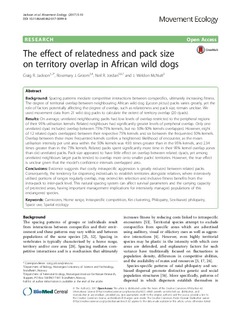| dc.contributor.author | Jackson, Craig Ryan | |
| dc.contributor.author | Groom, Rosemary J | |
| dc.contributor.author | Jordan, Neil | |
| dc.contributor.author | McNutt, J. Weldon | |
| dc.date.accessioned | 2017-04-28T11:34:58Z | |
| dc.date.available | 2017-04-28T11:34:58Z | |
| dc.date.created | 2017-04-20T22:13:43Z | |
| dc.date.issued | 2017 | |
| dc.identifier.issn | 2051-3933 | |
| dc.identifier.uri | http://hdl.handle.net/11250/2441238 | |
| dc.description.abstract | Background
Spacing patterns mediate competitive interactions between conspecifics, ultimately increasing fitness. The degree of territorial overlap between neighbouring African wild dog (Lycaon pictus) packs varies greatly, yet the role of factors potentially affecting the degree of overlap, such as relatedness and pack size, remain unclear. We used movement data from 21 wild dog packs to calculate the extent of territory overlap (20 dyads).
Results
On average, unrelated neighbouring packs had low levels of overlap restricted to the peripheral regions of their 95% utilisation kernels. Related neighbours had significantly greater levels of peripheral overlap. Only one unrelated dyad included overlap between 75%-75% kernels, but no 50%-50% kernels overlapped. However, eight of 12 related dyads overlapped between their respective 75% kernels and six between the frequented 50% kernels. Overlap between these more frequented kernels confers a heightened likelihood of encounter, as the mean utilisation intensity per unit area within the 50% kernels was 4.93 times greater than in the 95% kernels, and 2.34 times greater than in the 75% kernels. Related packs spent significantly more time in their 95% kernel overlap zones than did unrelated packs. Pack size appeared to have little effect on overlap between related dyads, yet among unrelated neighbours larger packs tended to overlap more onto smaller packs’ territories. However, the true effect is unclear given that the model’s confidence intervals overlapped zero.
Conclusions
Evidence suggests that costly intraspecific aggression is greatly reduced between related packs. Consequently, the tendency for dispersing individuals to establish territories alongside relatives, where intensively utilised portions of ranges regularly overlap, may extend kin selection and inclusive fitness benefits from the intra-pack to inter-pack level. This natural spacing system can affect survival parameters and the carrying capacity of protected areas, having important management implications for intensively managed populations of this endangered species. | nb_NO |
| dc.language.iso | eng | nb_NO |
| dc.publisher | BioMed Central | nb_NO |
| dc.relation.uri | https://movementecologyjournal.biomedcentral.com/articles/10.1186/s40462-017-0099-8 | |
| dc.rights | Navngivelse 4.0 Internasjonal | * |
| dc.rights.uri | http://creativecommons.org/licenses/by/4.0/deed.no | * |
| dc.title | The effect of relatedness and pack size on territory overlap in African wild dogs | nb_NO |
| dc.type | Journal article | nb_NO |
| dc.type | Peer reviewed | nb_NO |
| dc.source.volume | 5 | nb_NO |
| dc.source.journal | Movement Ecology | nb_NO |
| dc.source.issue | 10 | nb_NO |
| dc.identifier.doi | 10.1186/s40462-017-0099-8 | |
| dc.identifier.cristin | 1465799 | |
| dc.description.localcode | © The Author(s). 2017Open AccessThis article is distributed under the terms of the Creative Commons Attribution 4.0 International License (http://creativecommons.org/licenses/by/4.0/), which permits unrestricted use, distribution, and reproduction in any medium, provided you give appropriate credit to the original author(s) and the source, provide a link to the Creative Commons license, and indicate if changes were made. The Creative Commons Public Domain Dedication waiver(http://creativecommons.org/publicdomain/zero/1.0/) applies to the data made available in this article, unless otherwise stated. | nb_NO |
| cristin.unitcode | 194,0,0,0 | |
| cristin.unitname | Norges teknisk-naturvitenskapelige universitet | |
| cristin.ispublished | true | |
| cristin.fulltext | original | |
| cristin.qualitycode | 1 | |

